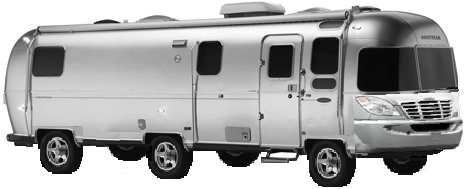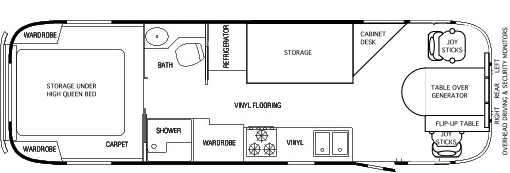30' 6WD AirRiver Motorhome


Most motorhomes were designed to provide families with all the amenities on a weekend getaway, so they have extremely limited storage, which makes them impractical for extended trips. In reality, many if not most motorhomes are used by couples, particularly retired couples. This motorhome targets adventurous retirees and childless couples, survivorists, hobby and commercial prospectors and hobby and university wildlife monitors.

Six Siemens eCorner in-wheel motors or equivalent (AISIN AW CO, LTD EV Drive System) provide coordinated tight turns. Power is sent to the wheels with the most traction during acceleration, and derived from those with the most traction during regenerative breaking. Volvo has a concept video. Vertical actuators increase the ground clearance for off-road use, level the vehicle when parked for sleeping, and lift one wheel from the road for tire changing.
Electricity-generating shock absorbers make rough roads profitable.
Joysticks on both front seats allow either person to drive the vehicle. Tilting either joystick left or right turns the vehicle left or right, respectively. Pulling the joystick back brakes the vehicle. The vehicle can turn on its center by pushing one joystick forward while pulling the other backward much like a treaded vehicle is steered.
Both seats swivel and reclining
Large fresh water, gray water, sewage and fuel tanks are centered for balance when empty or full. Batteries are distributed throughout the frame to balance the weight of the engine and the primary battery pack under the queen bed, which rolls aft for servicing and exchanging with a fully charged battery pack charged at home or exchanged at a service station. The generator will maintain battery charge when traveling a level 60 mph. Less driving demand will result in battery charging, and vice versa, allowing the generator to be small enough to be used for powering the lights, pumps, radio, TV, computers, refrigerator-freezer and microwave oven when parked.
Options:
Extending the awnings on both sides reveal an array of solar cells that augment the array on the roof. The back of the storage cabinet folds out to provide a bed for sleeping under the stars or for guests. When traveling, guests sit on folding seats that latch to floor fittings as desired. Storage can be sacrificed for an electric stove and oven.
Extreme off-roading is provided by extending the wheels beyond the exterior of the vehicle, and adding tracks around the two rear wheels on each side or all three wheels on each side.
Airstreams are the best (lightest), but this dual rear axle GMC would be easy to convert into 6WD motorhome with wheel motors from PML and a Compact Dynamics Range Extender in lieu of the Oldsmobile front wheel drive gas guzzler (8-10 MPH).
Here is a 23' GMC.
Foreign multi-passenger vans for possible conversion:
KINGSTAR VENUS 15 Seats Minibus
KINGSTAR NEPTUNE 13 Seats MPV
Toyota tourist buses
Australian Campervans
New concepts:
Tow a pontoon boat in three or four stacked sections that are driven off each other, widened for stability, and assembled using a remote controller. On to the pontoons the RV is driven. Each section has four in-wheel motors. The one on the ground during "towing" provides its own motive power and can help push the RV forward or pull it in reverse. The twelve or sixteen wheels drive the rig into the water from a boat launch ramp or beach. On each of the wheels not used for towing is a paddlewheel for marine propulsion. Some of the hulls can be partially filled with water or fuel. Each wheel has its own set of batteries (thick cables) that are charged from the RV (thin cables).
To avoid the need to elevate a long RV to handle dips and make it more maneuverable in tight turns, make the RV articulated in three axes, and separable into a controller-storage section, kitchen-bath section and bedroom-clothing section. Each section has four in-wheel motors. The controller-storage section can be driven separately as a jeep with gold prospecting, fishing, hunting and other equipment appropriate for the trip. Each section has a weatherproof double pocket door that can be locked when the section is separated from the others. The doors are normally closed during ground transit to keep dust out. The edges of the sections are reenforced with bumpers. The gimbaled couplers of the sections are spring-loaded such that they extend as necessary to accommodate turns.
None of the wheels turn for conventional steering. Each section is driven as a tank. When coupled, the speed of the wheels on each section are automatically coordinated for the turns of the assembled vehicle. The same is true of the pontoon paddle wheels.
If waterproof in-wheel motors cannot be had, I make my own. To avoid complete submersion and to minimize motor axle loading, each wheel can be a pair of wheels sharing an axle attached to a strut attached to the vehicle. Pressing against the top of each rubber wheel is a low pressure rubber wheel, which is attached to the axle of an electric motor that extends from both ends of the motor.
These wheel motors may be had as surplus aircraft landing gear assemblies that have an electric motor that spins the wheels before landing to minimize tire ware on touchdown.
The pontoons can have struts that can elevate the entire system out of shallow water, like that off the coast of Caye Caulker or any land protected by a coral reef to avoid mosquitoes.
| W. T. Holmes | Activities | Motorhome |